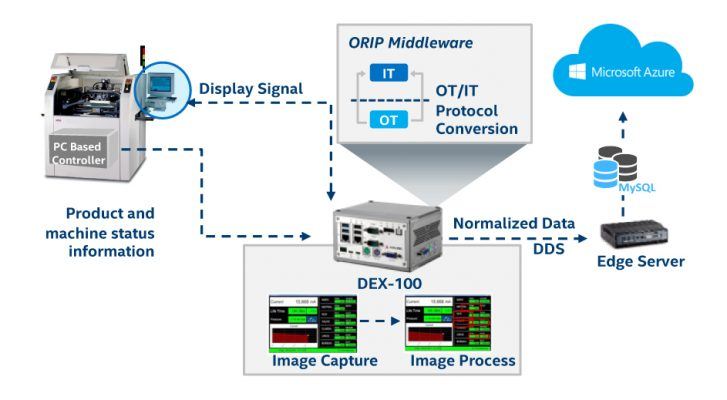AI Brings Old Assets into the Industrial IoT
The Internet of Things (IoT) can transform manufacturing—but only after businesses connect their old equipment. An incredible 92% of the world's 60 million machines are not attached to any network. The reasons are many, but a significant factor is that equipment investments are large and long term.
Most factory assets are kept in operation for years, if not decades. This creates a dilemma for equipment installed before the IoT era. Many of these legacy machines lack network connections or the software capabilities to interface with IT systems.
Until now, there was no easy way to connect these old assets to the IoT. But innovations in artificial intelligence and cloud services make it possible to upgrade the factory without replacing outdated equipment.
It starts by disconnecting the human-machine interface (HMI) display and rerouting that display signal through an IoT-enabled system as shown in Figure 1. Using modern AI techniques, this new system can capture information about the machine and the products it is manufacturing.

Next, the captured data can be converted into an IT-friendly format and sent to the cloud. This can all be done noninvasively, with no modifications to the machine or its software. “When someone offers a noninvasive method of pulling data from a machine, companies take note,” stated Daniel Collins, Director of IoT for the Americas, ADLINK. “What is being provided is a way to easily fill the gap between machinery and insight.”
Daniel points to the ADLINK DEX-100 Smart Manufacturing solution as an example. This solution can connect virtually any PC-based equipment to the factory's data network. What's more, built-in cloud connectors make it easy to route data to the cloud for enterprise-wide analytics and control.
Companies that have implemented the DEX-100 use it for data gathering and analysis, safety monitoring, and even machine-to-machine control. For example, at an SMT factory in China, this noninvasive approach allowed the manufacturer to extract about 85% of the data from 30,000 legacy machines and send that data to the cloud.
Machines Working in Harmony
But the benefits go far beyond simple data collection. The DEX-100 also connects to PC-based controllers' inputs, enabling remote configuration and operation of equipment.
“In PCB manufacturing factories, for example, operators use the HMI to enter data for the beginning of a lot run, and then collect data from the same interface at the end of the run,” explained Jason Ng, Sales VP APAC, IoT Solutions & Technology, ADLINK. “This is where errors can occur. Using the same interface, our solution eliminates human errors, enables machine health tracking, and helps improves overall equipment effectiveness.”
New applications today require machines to be interlinked and automated as part of a robotics system. For example, at one customer site, the DEX-100 is being used to link a computerized wire-cutting machine and a robot that holds the wire in place. The combined solution knows the positions of the wires, so the robot can perform the cutting and the soldering. This eliminates the need for a person to hold the wire in place and ensures consistent precision in the process.
Connecting legacy equipment to the IoT can also reduce downtime and guard against malfunctions and damage. Because alarms can be monitored remotely, problems can be addressed at the first sign of trouble. In contrast, an on-site operator might not immediately notice a problem—or might not be able to correct the situation right away.
Noninvasive and Scalable
The ability to monitor and control machines across an enterprise is also critical. “When we design a solution, ultimately, it has to be very scalable,” commented Ng. “There are many equipment manufacturers in the market providing machines that are both smart and not smart, with varying protocols. That makes it difficult to scale a single automation system for all of them.” But because ADLINK uses the set of interfaces common to all PC-based machines, their solution is inherently scalable.
Scalability and connectivity also apply to different clouds. ADLINK's smart factory solutions are designed for the flexibility required to engage the major cloud providers, such as Amazon Web Services, Microsoft Azure, and Google.
Connecting the Unconnected with Intel® Technology
With the amount of data from legacy machines that needs to be extracted, stored, secured, and processed in real time, the DEX-100 Smart Manufacturing Solution requires high-performance capabilities with built-in security. ADLINK relies on Intel® processors to protect, move, and process large volumes of data. And with extended availability of Intel processors for IoT applications, ADLINK can continue to support customers' needs for years to come.
One of the biggest problems facing smart factories today is not being able to leverage the power of edge computing and analytics. ADLINK is bridging the gap between the equipment and the data systems. And bridging that gap in a noninvasive way makes it compelling for businesses to bring their equipment into the realm of IoT.